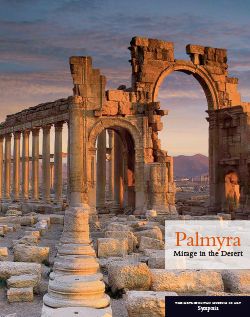Funerary relief
Not on view
Inscription:
(at right)
1 Alas! Tadmur,
2 wife of
3 Mokimu, son of
4 Nurbel,
5 the craftsman.
6 Died the
7 29th day
(at left)
8 of Siwan,
9 in the year
10 459.
Transliteration:
1 ḥbl tdmr
2 ʾtt
3 mqymw br
4 nwrbl
5 ʾmnʾ
6 mytt yw!m
7 20+5+4
8 bsyw!n
9 šnt 4.[100]
10 +40+10+5+2
This relief is a type of funerary monument characteristic of the prosperous caravan city of Palmyra during the first three centuries A.D. Reliefs with a representation of the deceased and a short identifying inscription were used to seal burial niches in elaborately decorated communal tombs; those with a half-length or bust format became prevalent sometime after A.D. 65.
The relief depicts the upper body of a woman dressed in a draped garment who faces directly towards the viewer. Her hair is covered by a turban-like headdress, worn over a diadem that covers her forehead. Curls of hair can be seen at the temples, where it is gathered up over the diadem and under the headdress, while long, wavy locks fall to either side of her neck, reaching the shoulders. She wears a long veil over her head, covering the left arm and leaving only the hand exposed. The right forearm is bare and the hand draws a looped fold of the veil over the chest from the left side. Her expression is serene, and her gaze does not meet the viewer’s but looks far into the distance. The iris and pupil of the eye are marked by incised concentric circles, and the eyebrows are indicated by modeled ridges. Her small, thin-lipped mouth is framed by softly modeled cheeks. An inscription in Palmyrene Aramaic, visible over both shoulders, gives her name and her husband’s name, and records her date of death. The months of the Palmyrene calendar were based on the earlier Babylonian calendar, while the years were reckoned according to the Seleucid era, which began in 312 B.C.
Due to rights restrictions, this image cannot be enlarged, viewed at full screen, or downloaded.





